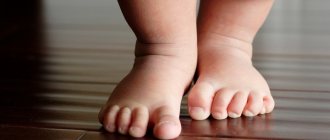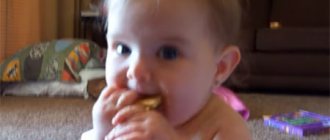The birth of a baby is a miracle that turns the whole world of young parents upside down. But an even greater feeling of real magic occurs when a newborn smiles his first toothless smile, which wins the hearts of even the most inexperienced, timid and strict mothers and fathers. That is why every couple who have recently become parents wonders when the newborn begins to smile.
More articles related to your question
- When will the baby begin to see and hear others clearly?
- Development of a 12 month old baby: new achievements - new opportunities
- When should a baby learn to hold his head up?
- Baby at two months: toothless smile and amazing skills of your baby
- What to do if your baby is thumb sucking
- The baby is capricious: instructions for action
When the baby smiles, fatigue goes away, mood improves, and new strength appears. Parents are inspired by that toothless, hesitant smile. They see that the baby loves them, is happy and healthy. So, when does this miracle happen?
When do babies start dreaming?
Why does a baby smile in his sleep? Does he dream? They say that newborns smiling in their sleep see angels. Sometimes sleeping babies begin to sob and move their legs. What experiences make newborns cry in their sleep?
When a child has his first dream
For a long time, humanity lived with the axiom that a child first dreams only after birth. Not long ago, scientists proved that children dream while still in the womb. Already in the eighth week of pregnancy, simultaneously with the development of the visual organs, the baby begins to dream.
This message from Harvard psychiatry professor Allan Hobson changed the understanding of the scientific world and expectant mothers about human development in the womb. The baby inside the mother's tummy sleeps most of the time; the REM sleep phase, when dreams are seen, lasts four times longer in the womb than for us adults.
Read also: when do newborns begin to see?
What do children see in their dreams?
We can say that a child develops with the help of sleep, but this is still only speculation among scientists. What kind of dreams our kids have is yet to be discovered. What will this give the world? A new branch of pedagogy will develop - perinatal education and training.
The dreams of newborns consist of unsystematic pictures. Infants up to one year old can also see them. The more the child gains “life experience,” the more often the pictures are woven into a plot, colored by impressions and emotions. Until the age of three, your child is unlikely to be able to tell in detail what he saw in a dream. He will say one word - cat, bird or any other.
Real dreams, imaginative and emotional, filled with actions and storylines, your child will be able to tell adults only as he gets older, after three years.
According to Allan Hobson, there is no reason not to believe a serious scientist; dreams are primary. And this means that a little person is born with his own vision, with his own “map of the world.” And it is laid in the mother’s womb.
Take a closer look at what your child does in his sleep. If he smiles and snores calmly into his pillow, that’s great, it means he’s having good, good dreams. But when he cries, sobs, and shudders restlessly, this is a reason to think.
Usually unpleasant, frightening dreams visit sleeping babies due to worries or unresolved problems in real life. A child's nightmares can also be caused by a sleep disorder. These problems need to be solved together with a pediatrician or child psychologist.
Everything in a person has its origins in childhood. And character, and habits, and evil, and virtue. That's what psychologists say. Or maybe even earlier, before birth?
razvitie-krohi.ru
Should I teach my baby?
Learning the art of smiling should begin from the first day of a child’s life. And the best exercise is your own example. The more often adults smile at a child, the more often he sees such facial expressions, the more likely he is to want to repeat it and smile back. Therefore, the main thing is communication, an emotional exchange of joy combined with touch and a gentle voice. All this will help the child quickly understand that he is completely safe, that the world he has come into is not at all hostile.
It often happens that after the first smile, the baby stops making parents happy with it and does not repeat this facial expression for a long time. It happens.
Sometimes parents don’t notice that they themselves spend most of the day with a gloomy and stern expression on their faces. Children, like highly sensitive detectors, instantly “read” this and try to imitate their loved ones. Such parents need to learn to smile and show their own emotions with their child.
A little later, the child will begin to laugh, usually by 5 months. And at first, strange sounds may frighten him. Here it is better for parents not to interfere; pretty quickly the baby will understand that he can make strange frightening sounds on his own, and therefore they are not at all dangerous. From this moment on, a period of laughing for no reason begins - the child is simply “rehearsing”, and the mother begins to worry that he laughs at everything and all the time.
Reasons for concern and contacting a doctor
The lack of a smile in itself is not a reason to sound the alarm. Functional disorders are accompanied by several additional symptoms. You should consult a doctor if, in addition to a smile, you have the following symptoms:
- the baby is not able to hold his head up, even when he should have learned this according to all existing standards;
- he is closed and does not make contact with anyone, including his parents;
- have difficulty focusing on one thing for a long time;
- at an older age there is a tendency to hysterics and boycotts.
Don’t rush to take your child to the doctors again. Perhaps your baby is special, he is thoughtful and does not want to smile in vain. If all other medical indicators are normal, most likely the problem is in the child's temperament. There is a time for everything, so there is no need to try to cure something that does not require treatment. It is much more effective to let the baby know that he is safe and everyone loves him
Just give your child care and attention, and you will see that he will soon answer you with a smile.
Pediatrician, allergist-immunologist, graduated from Samara State Medical University with a degree in Pediatrics.
How to stimulate skill?
The baby will definitely learn to smile and will do it with undisguised pleasure if from the first days of his life he is surrounded by the attention and love of adult family members. The more often he sees smiles around him, the faster he will master this amazing skill. Little ones imitate a lot, and their parents’ own example is the best teacher. In addition, a smile is a sign of good nature and safety, and newborns can feel this intuitively.
The more sincere the parent's smile is, the faster the child will understand that this facial expression is very good and will try to repeat it. The development of a smile is facilitated by massage of the baby’s palms and fingers, daily restorative massage, and fun exercises that will not only be gymnastics for muscle development, but also training for the child’s emotionality.
It is for this reason that it is always recommended to accompany the massage with songs and rhymes, funny jokes, and counting rhymes. A child in the first months of life does not perceive the words of an adult; it makes no difference to him what exactly is being said - children’s poems or the multiplication table, the main thing is the tone, intonation, and emotional coloring of the speech.
A newborn smiles when he sleeps, we understand the reasons
It is necessary to pay close attention to the behavior of the baby, both during the day and at night. Smiles and grimaces should not be a cause for concern, but some symptoms require medical attention. Especially when they do not cease to appear over time.
What can babies do at rest:
- grunt and strain;
- to fart;
- shudder;
- wave your arms and legs;
- toss and turn;
- tremble lips, chin;
- grimace;
- cry;
- moan;
- breathe frequently;
- hiccup;
- open your mouth;
- sweat.
Sleep phases in infants
The sleep of adults and children is divided into periods ranging from 50 to 120 minutes.
The phases are classified as follows:
- calm;
- restless;
- superficial;
- deep;
- slow, very deep;
- paradoxical.
Infants from birth to 6 months experience an alternation of calm and restless phases:
- Restless - accompanied by muscle relaxation and is considered complete rest. During this period, peace is very sensitive; the baby can wake up from the sound of a voice or movement in space. Its duration is up to 60% of rest.
- Calm - consists of alternating shallow and deep sleep. The baby's facial muscles are relaxed and the eyeballs do not rotate. This phase is characterized by absolute rest, without reaction to external stimuli.
It is important to know! With age, after 6 months, the child develops a phase of paradoxical (active) sleep, when the brain is actively working. After two years, a small person has the same sleep cycles as an adult. . Brain function while the baby is resting
Brain function while the baby is resting
Rest is necessary to reset the central nervous system and process the information received during the day. It is a mistaken belief that at night the brain turns off other functions of the body; they simply go into different phases of activity.
During sleep, the brain is maximally removed from external factors. The life activity regulator is, as it were, closed on internal systems, their work is debugged and cells are restored, and human biorhythms are adjusted. The difference in brain activity is clearly shown by the data of the encephalogram, which is taken during sleep and wakefulness.
Brain structures interact with each other in the paradoxical phase, this process is accompanied by the emergence of dreams. They are as saturated as possible after a day rich in emotions and events.
Peculiarities
A newly born person smiles. But he does this unconsciously. Such involuntary smiles are associated with the rapid formation and “debugging” of the nervous system, which began during the period of intrauterine development and continues during the first years of the child’s life. A fleeting unconscious smile appears on the face of a newborn at any time when his body is sufficiently relaxed - in a dream, during water procedures, after feeding. This first physiological smile is not addressed to absolutely anyone - not mom, not dad, not even grandma, no matter how much the latter might want it.
A baby can begin to smile at a mother or another adult who is caring for the baby and communicating with him only after a number of important conditions have been met in his body:
- facial muscles are ready and “ripe”;
- the child’s psycho-emotional sphere is developing successfully;
- the nervous system is ready to activate the facial muscles of the child’s own will;
- hearing becomes more acute;
- vision develops and the baby can already examine the face, focus his gaze on it, there is recognition of faces.
A newborn does not have all these skills. He has another, louder tool for communication - shouting. By screaming, he shows that he is hungry, that he is wet or in pain. This is not to say that a newborn is devoid of emotionality, this is not true. But it is of a different nature and is aimed at providing the first and most natural needs - nutrition, safety, survival.
An emotionally conscious smile usually appears at the age of 2-3 months. A child can not only smile broadly and toothlessly at dad or mom in response to affectionate treatment or entering the children's room, but also demonstrates a clear sign of emotional maturity - a revival complex. He is animatedly waving his arms and legs, trying to bend his back.
Newborn groans in his sleep
As a rule, the reason for the appearance of groaning in a baby lies in constipation. If constipation is frequent, ask your doctor for help. Many mothers resort to using an enema or laxative. These methods are good, but they should not be abused. In addition, groaning is caused by intestinal colic.
At the end of feeding, the baby produces gases, which put pressure on the intestinal walls and lead to pain. In order to avoid unpleasant sensations, the baby should be massaged on the abdomen, carried vertically for a while, so that the air space moves away from the esophagus. To prescribe medications that reduce gas formation in your baby, contact your pediatrician.
The meaning of smiles
After the baby adds the additional ability to smile to his usual screaming, he will use smiles to express a wide variety of emotions. Of course, first of all, to demonstrate the joy of seeing a loved one. Also, from 2.5-3 months, the baby begins to express pleasure with smiles. A well-fed, dry, healthy child can contemplate the mobile above the crib or the ceiling for quite a long time and smile blissfully.
After six months, many babies begin to smile not only at their mother and their favorite toys, but also at strangers who approach them - a pediatrician at a clinic appointment, a massage therapist, a neighbor on the landing.
When does a baby start to really smile?
In order for your baby to give you his first conscious smile, he must go through several important stages in his development.
A child is born with imperfect vision. He sees large, large objects well at a distance of 20-30 cm. The child sees his mother’s face slightly blurred. Normal vision develops around the age of one month; it is then that the child begins to distinguish the facial expressions of adults and tries to “copy” it.
A huge amount of work is done by the baby and his psyche. After all, you need to understand that the appearance of a face in the field of vision is associated with the pleasant feelings that it experiences, and remember how you can express your pleasure.
To smile, you need to use 17 muscles. Imagine the work your child does!
Typically, babies begin to smile consciously between 6 and 8 weeks of age. The neurological norm is more vague - from 5 to 12 weeks.
This new smile is easy to distinguish from a reflex smile, since it is intended for a specific person. When a newborn begins to smile consciously, it cannot be ignored.
How does a skill develop?
Conscious smiling becomes possible when the baby successfully passes the primary stage of mental and emotional development. The newborn has almost no contact with the outside world; he is in a state of deep internal concentration. This is important so that the process of adaptation to a new environment, different from the intrauterine one, proceeds more quickly. The only way of contact at this age is crying. To them, the child shows his displeasure with wet diapers or fatigue, hunger or pain.
A smile as a reaction to recognition, to a loved one, comes later than an unconscious smile. Many have noticed how newborns smile in their sleep. It is difficult to judge whether they dream, but science does not exclude this. However, a smile or half-smile in this case is an expression of the development of the baby’s nervous system - an involuntary impulse contraction of the facial muscles.
This first smile is not associated with emotions, it is purely physiological. But a baby can smile emotionally at his mother no earlier than he begins to recognize her face and distinguish it from other faces and objects. By the end of the second month of life, the baby’s vision becomes more acute; he can already briefly focus his gaze on faces and objects located close to his own face. It is at this age that a baby can show his first real smile.
The ability to express emotions with a smile is of great importance and never appears in isolation from some other skills. As soon as a toddler at 2-2.5 months begins to recognize his mother and father, he can not only show this with a smile, but also demonstrates general animation: in response to his mother’s voice or touch, he begins to intensively wave his arms and legs, arch his back, lifting his tummy up. Some begin to gurgle and coo at 2 months, and the first sounds in most cases also coincide with the first full smile.
We invite you to familiarize yourself with: The meaning of the name Vitaly, origin and characteristics
All these signs mean timely and normal emotional and mental development, which for a baby is no less important than physical development.
Baby smile from 2 to 6 months
At 2-3 months, you will begin to notice that your baby looks at you when he smiles. The child will become increasingly responsive to face-to-face interactions. You can easily make faces to make your baby laugh. There is no need to force your child to smile - just try to make him laugh.
From 4 to 6 months, the child may first smile and then turn away. The baby learns to regulate his emotions. Joy can be too intense an emotion. Allow the child to turn away, and if the child later smiles at you again, you can repeat the demonstration of funny images. You may notice that along with a smile, the baby begins to react with his body: he moves his legs and arms, looks at you and those around him. Starting around this age, the baby learns to increase and decrease his emotions. Over time, he begins to use other methods of reacting and communicating with others.
Doctors warn: if the child does not smile by 3 months, you need to visit a doctor.
Smile as a way of communication
Everyone knows that constant communication with a baby helps him develop faster, but not everyone knows how to provide for it. Meanwhile, pediatricians advise mothers who see their baby’s first smiles to provoke them more often. How, you ask? For example, talk to him, make faces at him, coo. Moreover, in the end, a couple of months of such communication will develop into a stable relationship between mother and child.
Interestingly, scientists have conducted a lot of research in this area. Within their framework, they observed children in their first year of life. This allowed them to make sure that the babies’ first smiles indicate their emotional communication with the outside world. With them they “speak” not only that they are warm, but also that they are pleasant, convenient, and comfortable.
Later, emotions develop, and along with them other skills appear. For example, children 10–12 months old, for example, who know how to distinguish “living” from “non-living,” are able to react emotionally to familiar people and familiar things. At moments of “recognition,” they often move their arms and legs and look into their eyes. In medicine, all this is called the revival reflex and indicates excellent development.
A smile on a child's face - different theories
A smiling baby is a wonderful sight. I would like to think that a peacefully sleeping baby is absolutely happy, that this is not just physiological relaxation of the facial muscles.
Pleasant dreams
Dr. Komarovsky believes that when a newborn baby sleeps peacefully and smiles in his sleep, this is caused by pleasant dreams. The baby’s brain analyzes the information received during the day, and it evokes positive emotions in him. Laughter in a dream should alert you, which indicates a violation of the baby's daily routine. An overabundance of impressions (meeting new people, a change of environment) or physical activity before bedtime causes stress, which can provoke laughter during sleep. The doctor believes that it is the parents' responsibility to provide the baby with peace before going to bed.
Indeed, it has been scientifically proven that after 1.5 months, babies develop an active sleep phase, during which they dream. Positive emotions during the day (breast milk, mother's hugs, laughter) are projected into dreams at night, which is why healthy newborns smile in their sleep.
It is important to know! Infants' vision is imperfect, so dreams come to them not in the form of pictures, but as a stream of pleasant sensations.
Somnologists believe that dreams activate the central nervous system. The combination of positive moments during the waking period causes sweet dreams.
There is also an inverse relationship: if a child is in a state of stress and anxiety during the day, then he does not dream of anything. This introduces dissonance into the development of the baby's intelligence. Parents must provide coziness and comfort to the baby.
Emotionless grimaces and phase changes
Doctor Elena Malysheva claims that a smile in a baby’s sleep is a grimace that appears after the muscles relax. This facial expression was recorded even during the period of intrauterine development. Frequent laughter in a dream may indicate serious brain pathologies. Parents should not be touched, but be wary and consult with a pediatrician.
If the child eats well and is active, then the situation when babies smile in their sleep should only cause pleasure.
In addition to smiling, the baby may frown or wince. Such grimaces are characteristic of the phase of paradoxical (active) sleep, when nerve impulses cause involuntary contractions and relaxations of the facial muscles. When changing phases, the baby may scream or cry, but quickly calm down without waking up.
Such phenomena should not cause concern to parents; they indicate that the baby is growing up. During the slow, deep phase of sleep, the face is completely relaxed.
What do smiles mean?
The first grimaces on the face of a newborn may begin to appear within a couple of days after his birth.
Sometimes these grimaces are perceived by parents as proof that their baby is happy, that he is happy with them. But it is not so. In the initial period, a baby’s smile is only the nature of a reflex and does not in any way indicate that the baby is reacting to people close to him. Children can smile reflexively while bathing, while feeding, and even while sleeping. Many parents ask why their newborn smiles in his sleep. Moreover, a smile can begin to appear on a child’s face literally on the very first day or two from the moment of birth. The fact that a newborn smiles at this age just means that he is calm and that he is feeling good.
At the initial stage, the child smiles reflexively.
Previously it was believed that the reason was that the baby had lost his gas, but this is not the case. The baby smiles when he is comfortable. This smile does not play any social role. It appears during feeding or sleep.
Since an infant is significantly limited in the ways of expressing his emotions, his cry and his smiles can mean a fairly wide range of emotions. This is not only the joy of recognizing a loved one, but also evidence of well-being. So, a baby can smile just like that when he is full, when he is dry and warm, when he is sleeping and nothing bothers him - no colic, no gas, no extraneous sounds.
Inappropriate smiles play a big role in diagnosing mental illness and autism spectrum disorders, but only after the child turns 3 years old. By this age, mental illnesses, if present, will have other symptoms and manifestations.
As their speech function develops, children begin to smile more specifically, and may also smile in their sleep when they see familiar images or dream about their mother. Other types of smiles (mocking, for example) are not familiar to children. They will become acquainted with them later, usually after two years.
At what age does a child begin to smile?
When a child begins to smile, parents and loved ones rejoice. Of course, finally this little man not only cries, but also laughs. But this element of development is important not only from the emotional side, but also from the physiological side. The first smile that appears on time is a sign of normal mental development of the child.
Any pediatrician will tell you what time a child begins to smile back at his mother. On average, this is 6-8 weeks of age. Sometimes a little earlier or a little later. Much depends on the people around the child. If you often carry him in your arms, sing to him, talk to him, caress him, the child begins to smile consciously already at 1 month
, if less attention is paid to the emotional sphere, then at 2 months. But you shouldn’t believe mothers who say that their children began to smile in the hospital, that is, immediately after birth. At such an early age, only grimaces are possible, but not conscious smiles. And the child will certainly not be able to smile in response, since his vision is still quite poor.
A smile is one of the components of the so-called revitalization complex - the emotional-motor reaction of a baby to an adult. This reaction begins to appear at about 3 weeks of the baby's life. At such a young age, he only freezes and concentrates when spoken to. A little later, a smile, humming, and motor animation appear as a reaction to communication with an adult. The revitalization complex reaches its apogee at 4 months. Later, the child’s behavior becomes more complex and varied. He may react to unfamiliar adults, even if they speak kindly to him, by crying. But at this age, he no longer just smiles, but laughs boisterously.
How to make your child smile faster? Just love your baby and everything will work out. Be sure to talk to him, even if you think he doesn’t understand anything yet. Children whose parents did not talk to them develop more slowly. Later they begin not only to smile, but also to walk, make sounds and speak.
The most successful, appropriate moment to evoke a conscious smile in a child is to gently touch him or simply smile when he is engaged in learning about the world - he turns his head, tries to grab toys with his fingers, carefully examines some objects, tries to walk and move.
Did you find the answer to your question?
Not really
Subscribe to our channel in Yandex.Zen
|
|
|
|
|
|
Is it possible to speed up the process?
It turns out that this question was asked not only by young parents, but also by scientists and pediatricians.
As a result, the latter managed to establish certain factors that make it possible to bring the hour “X” closer, namely:
- active communication with the baby. If you talk to a child about something, he will probably answer, for example, he will hum, grunt, and make other sounds;
- frequent touching. Stroking, light massages, affectionate treatment makes children freeze, listen to their feelings and, if they are pleasant, smile in response to them.
But most importantly, in order to quickly see a smile on your child’s face, you need to smile at him more often.
At what age does a baby begin to smile and laugh consciously?
Conscious emotion is a matter of time and painstaking work of the body. Every day expressing our emotions in this way, we don’t think about how many dozens of muscles are put into action and brain impulses are made before the mouth stretches into a sincere smile. Such complex operations become possible for the baby from 4 weeks after birth. Due to individual characteristics, this period can last up to 8 weeks; this is the norm.
There is no need to worry if the newborn is in no hurry to please his parents with a smile or does it rarely. Remember, among adults there are also people with different characters and temperaments. Perhaps your baby is growing up as a serious person and is not going to smile at little things
Pay attention to your emotional background and to your spouse. Your baby's sullenness may be a reflection of the example you set every day.
At the same time, the absence of a smile for more than 8 weeks indicates a violation of the child’s mental and physical health. It is associated not only with emotions, but also with the beginning of speech development. To prevent your baby from remaining gloomy, give him a lot of attention. Show bright pictures, tell stories, be around all the time. Non-verbal contact is important - the use of gestures and facial expressions.
A variety of toys stimulate laughter—give preference to bright and noisy ones. Use colorful cards and say what is shown on them. Starting from six months, teach your baby the sounds that animals make. He remembers syllables well, and this contributes to development, including emotional development. To make your baby laugh and smile, do it yourself.
Reasons for his absence
Violation of the timing of emotional development can be observed in premature babies whose birth occurred prematurely. For some time they have to “catch up” with their peers in many respects, and therefore the emotional sphere of children begins to develop a little later. But involuntary smiling, even in premature babies, usually appears already in the first days of life. These babies, just like full-term babies, can roll their eyes when they fall asleep and smile.
A certain violation of the timing of psychological maturation can also be observed in children who experienced physical distress during pregnancy - Rh conflict, hypoxia, chronic lack of vitamins and minerals. Birth complications, head and cervical injuries, as well as cerebral hemorrhage after birth can also lead to disruption of the functioning of some parts of the cerebral cortex and slower mental maturation or the development of mental illness, but it is almost impossible to diagnose them at such a tender age.
Doctors have long noticed that children who were abandoned at the maternity hospital and ended up in an orphanage begin to smile very late, and some do not want to do this at all. In this regard, experts have concluded that contact with the mother (tactile, vocal) is very necessary for the baby from the very first days. Deprived of this contact, an infant feels lonely, and the development of his emotionality is very slow.
It is noteworthy that the most important thing is tactile contact. This can be easily understood by analyzing how children who are deaf or blind from birth learn to smile. They do this at approximately the same time as healthy peers, under the obligatory condition that the mother is nearby, she touches the baby, strokes him, and breastfeeds.
Much depends on the character of the baby himself, on the type of temperament with which he was born. Thus, sanguine and choleric people begin to bloom with reciprocal smiles somewhat earlier than drowsy and lazy melancholic people. In general, there are children who first start frowning - it looks very funny and unusual. But this can also be considered a manifestation of normal mental development.
Newborn crying in his sleep
There are situations when a newborn cries in his sleep. The baby is crying, which means something is bothering him. If your baby is teething, this may be a circumstance. In addition, the baby may cry because the mother is not around (if the baby is sleeping in the crib). If the baby cries quite often at night, it is possible to switch to co-sleeping.
Under such conditions, the baby will feel the mother’s warmth and can always be fed if he is breastfed. The most common cause of crying during sleep is colic.
Doctor Komarovsky's opinion
A well-known and popular children's doctor and TV presenter among mothers, Evgeniy Komarovsky, claims that the baby just needs time and parental participation. It is these two factors that determine the psycho-emotional development of the toddler.
If the mother has only complaints about the lack of a conscious smile, and in all other respects the child is healthy and develops according to age, eats well, sleeps, walks with pleasure, is interested in surrounding objects and toys, then parents have no reason to worry, Komarovsky believes. But the absence of a smile, combined with the absence of attempts to raise the head when lying on the stomach, lack of eye contact (the child does not look at the mother), pale skin, weakness, poor appetite, frequent regurgitation, neurological symptoms - is a reason to show the child to the doctor - neurologist.
To see when a baby begins to smile consciously, watch the following video.
Baby smile from 6 to 12 months
During this period, different children's smiles will already appear. As a rule, these will be open smiles, more showing joy. The baby will also start playing with laughter.
thinkstockphotosfotobank.ua
From 8-9 months, the child will begin to use a smile as a method of communication with the surrounding society. If a child smiles at you, be sure to smile back. He will wait for a response smile to make sure of your contact with him. Now he smiles consciously, showing you his positive emotions or reacting to a person.
We briefly looked at why a child smiles and how his perception of the world around him changes along with this. Now your task is to give your child a pleasant atmosphere and affection. Record the details and reasons why and when the baby smiled. This will help you understand what brings him the most joy. And don't forget to smile yourself!
How to behave to make your baby smile?
Pediatrician scientists and child psychologists tried to find out the reasons for children's smiles. They came to the conclusion that some actions of others can be an additional stimulus for positive emotions. Specialist in communicative exchange between children and adults M.I. Lisina identified a number of actions that can make a child smile:
- The first action, paradoxically, is the absence of any action. Children love to attract attention, so a sullen adult instantly becomes a “target.” The baby actively “communicates” - smiles, laughs, coos. When a child starts laughing loudly, he may simply be doing his best to make the sullen adult laugh back.
- An adult's smile evokes a mirror response. This is especially true for parents and other “friends” adults. The kid already roughly understands who he needs to follow as an example, and is actively involved in this. If the parents are constantly in his field of vision, talking calmly and smiling, the child also begins to actively show positive emotions.
- Conversations. Of course, the baby is still too small to understand the meaning of speech, but he reacts very well to intonation. It may even actively “respond” through grunting, humming and other sounds.
- Make tactile contact. Touching and stroking soothe, makes you feel comfortable and, of course, makes you smile.
- Use all the suggested methods. Any task must be approached comprehensively. In order for a child to feel comfortable, both tactile and verbal communications are important.
A child’s smile, like an adult’s, is a means of expressing positive emotions. A mother usually feels her child, and therefore making him smile is not a problem. You just have to listen to your feelings to understand what will bring you the most pleasure. Perhaps the child misses songs or laughter, or maybe he wants a light massage or rocking.
The ability to smile is more than a physiological reaction. This is a small brick with the help of which further communication with people will be built.
Why does a child laugh in his sleep?
Little children are as beautiful as angels when they sleep. Parents can admire them for a long time. But one day, mom and dad suddenly notice that their infant is laughing in his sleep, then they will think: what does this mean, why is this happening. Let's look at this topic.
Why do small children laugh in their sleep?
For newborn babies, everything in the world around them is new, every day brings with it new impressions and knowledge. It is these emotions that are the reason that an infant laughs and talks in his sleep. When the day has been active and the baby has a lot of impressions, they will appear during rest. Moreover, both positive and negative emotions influence the child’s sleep equally. Therefore, experts advise adding new entertainment in doses to the life of a little person. Of course, if a child smiles and laughs, this is most likely a manifestation of positive impressions and pleasant dreams.
Changes in sleep phases can also cause your baby to laugh while resting. This is the second version that explains the phenomenon in question. It is known that the sleep phase can be fast and slow. At the border of the transition from one to another, the child may experience laughter, muttering, and movements of the arms and legs. This is normal.
Some believe that when a newborn baby laughs in a dream, it means angels are flying to him and playing with him. At such moments, they say, you should not wake up the baby.
All of the above explanations for laughter in a dream are not a cause for concern for parents.
You should seek advice from a specialist in cases where:
- I have nightmares, the baby screams often and loudly, wakes up and cries;
- the child walks in his sleep;
- you notice excessive sweating or signs of choking in your child.
In these cases, depending on the diagnosis, the doctor may prescribe sedatives and herbal remedies.
Gradual development of positive emotions
If a child does not smile, it is not at all necessary that he has health problems. Quite often the reason is a simple lack of a clear example. If it is not customary in the family to express emotions clearly, the household members are extremely serious and focused and behave with restraint, then the baby will copy exactly this model of behavior.
Children with whom they speak little, who do not see smiles from their mother, and who see their mother only during the next feeding, usually lag significantly behind their peers in psycho-emotional development. They simply have nowhere to take examples of emotions.
Other reasons for the lack of a smile in a baby may be as follows.
- The baby was born premature. Such children need more time not only for physical, but also for emotional development.
- The pregnancy was difficult. Any negative effects on the fetus during gestation can slow down its development after birth. The main factors are Rhesus conflict between mother and fetus, intrauterine chronic hypoxia.
- Difficult birth. Birth injuries, cerebral hemorrhage, ischemia, and acute hypoxia are dangerous.
- Neurological diseases, mental disorders, autism, dementia.
We invite you to read: Pumpkin cookies: simple quick recipes
But the fact that your baby began to consciously smile is just the initial step in developing his ability to respond to positive emotions. It is known that Mowgli children, who were raised by animals in infancy, never learned to smile, even after returning to human society. This skill appears precisely in society, and if the whole complex of “revival” is not included from an early age, then the opportunity to teach a child to smile and laugh will be irretrievably lost.
The intensity of the baby's behavior reacting to any positive emotions should gradually increase. It is believed that the “revitalization” complex goes through several stages.
- At first, the baby simply learns to fix his attention on a pleasant sound or on a familiar face. The reaction in this case will be a smile, joyful sounds, more active movements of the arms and legs. At the same time, the baby's breathing quickens. This manifestation of a reaction to a positive stimulus occurs, as we have already said, by the end of the first month.
- Next, the baby becomes able to react joyfully even to the approach of an adult who has not yet begun to show positive emotions towards him. At a certain age, a child may begin to smile first, making sounds and arching his back. In other words, the baby begins to develop the ability, which is very important for a modern person, to encourage others to communicate. Through his actions, the baby makes an independent attempt to establish contact. Such a complex is formed much later, by the third or even fourth month.
Most often, a child smiles in response to positive emotions directed towards him.
You should not perceive the deadlines we indicate as something obligatory and be afraid if, for example, your baby has not yet begun to actively smile by the end of the first month, and by the end of the fourth does not yet encourage others to communicate. All children are individual; there are active and calm children, choleric and melancholic children.
A recently born baby does not yet understand the words with which we address him, but he perfectly recognizes our emotions and intonations in his voice. Based on them, he is already able to judge how close people treat him, whether everything is fine in the house, whether his mother is happy, whether she is calm.
Any communication with the baby should be carried out only in a friendly manner. To help a baby discover the concept of a smile and teach him to interact with his family, little is required from mom and dad:
- hold the baby in your arms more often;
- pet him when he is just lying in his crib;
- talk to him, read him poems or sing songs;
- always smile at him.
The more you communicate with your child, the faster his psychological development will occur.
But you still need to try to evoke a reciprocal smile from the baby at the right time. If the baby is tired and drowsy, this is not the best time for smiling, you must agree. Here are some signs you can use to understand that your baby is ready to communicate:
- he clearly cannot lie in one place;
- his head turns all the time, he looks at the situation in the room;
- his eyes are wide open;
- the baby is bawling;
- The baby tries to grab everything he comes across with his fingers.
The successful development of the baby largely depends on emotional and physical contact with the mother. The more this contact there is, the earlier the moment will come when the baby begins to open his eyes wide in response to his mother’s appeal, and a reciprocal smile will clearly appear on his face.
An atmosphere conducive to a baby's restful sleep
Some children are characterized by increased excitability of the nervous system, which makes it difficult to rest peacefully and fall asleep quickly. Parents should create favorable conditions for the baby before going to bed.
What to do for a comfortable rest for newborns:
- Reorganize the baby's daily routine with an emphasis on night rest. During the day, wake up the child, play with him and feed him. Children do not divide the day into day and night. After one year of age, babies need to be taught to sleep at night and be awake during the day.
- Infants need to develop the skills to fall asleep independently. To do this, it is recommended to introduce evening rituals: bathing, dim lights, quiet conversations with a lower tone of voice, laying in a separate crib, lullabies, fairy tales.
- Putting newborns to bed at the same time and resting with them will promote a good feeding routine.
- Provide your child with a quiet walk before night approaches. He should breathe fresh air, but it is recommended to limit physical activity. You can simply ventilate the sleeping area.
- Control air humidity. If the atmosphere in the bedroom is dry, the nasal passages may dry out and then the baby will breathe through the mouth.
- Keep the room temperature no higher than 20 degrees;
- Fully feed before a night's rest.
- Provide a comfortable, soft sleeping set according to the season.
- Give your baby a bath before bedtime.
Little children smile in their sleep after an active day full of new experiences. The peace and safety of the baby are factors for which responsibility falls on the mother. Breast milk and mother’s warmth are factors that cause pleasant visions and the proper formation of the child’s nervous system.
Smile and baby development
A smile is the beginning of emotional and psychological development, the basis of communication with other people. At two or three months, when the child begins to smile, he begins to pronounce the first sounds. At first it's cooing and humming. The baby makes drawn-out vowel sounds, such as “a”, “o”, “e” or “u”. At 4-5 months, the consonant sounds “g”, “p”, “m” are added. Gradually he begins to pronounce the first light syllables, like “ma”, “ba”, “pa”, “da”.
A baby’s smile, emotional state and speech are inextricably linked. Therefore, it is important to do comprehensive developmental exercises with your child. To do this, constantly talk to your baby, explain every action, tell fairy tales and stories, nursery rhymes and poems, sing songs. Be sure to use facial expressions and gestures! This promotes speech development, will help make your baby smile and even make you laugh.
The development of the baby is ensured by bright and musical toys, games of hide and seek and peek-a-boo, and the attention of parents. Be sure to use cards, pronounce the names of the images with intonation and facial expressions. By the way, children at 6-7 months respond well to animal sounds. The baby will quickly remember sounds such as “mu”, “meow” and “woof”.
When the baby coos, repeat the sounds and add new ones. Talk kindly and calmly! Smile at your baby and he will smile back. It is no secret that children at this age copy the behavior, speech and emotions of their parents.
Do newborns dream or what do our babies dream?
Author: Ekaterina Chesnakova 08/25 A little about everything 0 comments
Hello, dear parents!
There is much in human nature that has not yet been understood by science, especially with regard to higher nervous activity, its material carrier – our brain. Philosophy cannot yet deal with the questions of what is a dream and what is reality. In general, complete mysteries.
Why did we take on such lofty matters, you ask? We were interested in the topic of the Morphean kingdom, because we spend about a third of our lives sleeping, not counting situations of obvious lack of sleep. This part of life is often not inferior to waking life in its brightness and the impressions it produces.
And how many great discoveries were made in a dream, that is, they simply dreamed! But when and where it all begins, whether newborns see dreams, scientists have not yet clearly established; there are different opinions. Let's try to organize the currently known information about this.
What it is?
Being in a dream, as a condition, is an integral part of our life, one of the basic needs; deprived of the opportunity to sleep, a person goes crazy and eventually dies. This is a special mode of functioning of the body, controlled by the brain.
In the “slow” phase, the sleeper regains his strength, complete rest, and in the “fast” phase, the information received by the central nervous system is processed, taking into account earlier experience. It is during this phase that we dream.
Such a concept as a dream is a much more subtle question; not everyone remembers what they dream, so they can claim that they do not dream, although in fact they simply do not remember them. Why are we so sure of this? Because in every person’s sleep there is a so-called “fast” phase.
At this time, eye movements are required, laughter, crying, and sometimes body movements are possible. Somnambulistic (aka sleepwalking) attacks also occur during this phase. The names “slow” and “fast” are given to the phases of sleep because of the differences in the electroencephalogram - different types of waves are visible on it. During an EEG study, these types of waves will be presented to us by sleeping adults and infants.
When do dreams come?
Some scientists believe that even the fetus in the womb has dreams. After all, he spends the vast majority of his time sleeping, gaining strength, and when he is awake, he makes it even more clear to his mother, especially if at that moment she herself is about to sleep or is already asleep.
In newborns, from the first days of life, the “fast” phase is precisely defined, and the baby sleeps much more than an adult - about 20 hours a day, maybe even more. Half of a baby’s sleep time is allocated to this phase (about a quarter for an adult).
The baby also shows other signs - eye movements, smiling, and maybe crying, twitching of arms and legs.
What to do if the child does not smile? How to teach a child to smile?
Your little one’s peers are already smiling with all their might, but yours is not, and it’s natural that you are worried. However, the norms for each baby are different, and the appearance of a smile is influenced not only by the natural physical and mental development, but also by the baby’s temperament.
The desire to communicate is inherent in every person from birth, and it is a smile that is the beginning and the basis for the interaction of two people with each other. Carry the baby in your arms, talk more, tell nursery rhymes and sing songs. Of course, all this needs to be done at the right time - if you see that the baby is carefully looking around, humming and trying to grab something with his fingers, then right now you should pay more attention to him. Affectionate and attentive treatment works wonders, and very soon your baby will delight you with his first smile!
Can anything please a young mother after a difficult day full of worries, after a sleepless night, more than the smile of her baby? Just his first smile! Agree, looking at this happy face with lips stretched out in an uncertain smile, you forget about everything in the world: about crying all night long, about a stiff back, about still fresh, not the most pleasant impressions from the maternity hospital and you understand that this is the miracle you love most of all in the world!
A child's first smile is a ray of sunshine for mommy.
Baby smile from 1 to 2 months
During this period, the baby's smile gradually becomes a reaction to stimulation from the outside world. He can react to mom clapping her hands, dad singing him a song, or to another pleasant event for him. A smile after the baby is fully awake usually appears for the first time between 6 and 10 weeks.
Children's brains develop gradually, their vision improves and the ability to recognize faces appears. First, the child will begin to respond with a smile to sound stimuli, then to sound and visual stimuli together. Lastly, a child's smile will appear in response to visual stimulation alone. At this age, it is very useful to sing pleasant melodies to your child, or turn on calm music. Such sounds will calm the baby and set him up for favorable emotions.
Fotolia
About the first conscious smiles
At what age do you think a baby smiles consciously for the first time? Pediatricians say that most often at the end of the first month of life. Although, due to her own individual characteristics, the mother may see the characteristic curvature of his lips in response to her words or actions much later. A smile at 6–8 weeks is not considered a deviation from the norm.
Why does it appear on the baby’s face for the first time so late? Doctors explain everything by its nature. The fact is that the expression of emotions on the baby’s face is preceded by serious brain activity, involving dozens of facial muscles through the use of nerve impulses. At the same time, of course, the baby must see the object of his admiration, and for this he needs to have fairly clear vision.
Moreover, the information about what he saw that enters his brain must be processed accordingly. In response to this, the child will finally be able to smile. Therefore, it is not at all surprising that this can happen even after two months from the moment of his birth.
By the way, you shouldn’t expect long-lasting smiles right away. Initially, they are fleeting and appear during the moments of swaddling, bathing or feeding the baby. For example, when he feels his mother’s gentle touch or hears the pleasant sounds of her voice.
Over time, the moments of expression of emotions by the baby will be extended. The main thing is to do your best to contribute to this. How? We'll talk about this further.
Joy is a sign of intelligence
A smile is caused, it is shared, it is given or hidden... Note that several sides are always included in “smiling formation” and this process is controlled by consciousness, while smiling or laughing for no reason is often perceived by adults as a sign of a weak mind. For infants, everything is different: for them, any manifestation of positive emotions indicates normally progressing mental development.
Take a closer look. At first, the baby will begin to slightly curl his lips, but this inept smile of his will be wandering and not addressed to anyone. What your mysterious little one Gioconda is thinking about at this time is not known for certain. But the fact remains that when a child feels bad, he “turns on the siren” and makes a completely different grimace, addressing it to the whole world at once (“Look what you are doing to me! How could this be allowed!”). When his basic needs are satisfied, he is warm, comfortable and well-fed, that is, there is no need to put forward “ultimatums”, the corners of his mouth stretch by themselves. Psychologists call this “primary smile” physiological or reflexive. Simply put, just as a full bladder leads to involuntary urination in an infant, favorable environmental conditions paint something resembling a smile on his face - it is generally accepted that consciousness has nothing to do with this. And only when the child learns to look beyond his nose (in every sense, because babies are myopic), finally sees you, the loving mother bending over his crib, and smiles specifically at you - then he will begin to turn into a Reasonable Person. “Now I feel good and pleased. Thanks to all. I’m very glad that I’m in good and kind hands,” he tells you with his appearance.
And this first joy of the baby is no less important for his young mother. While the memories of labor pains, pushing, white coats, etc. are still fresh in your memory, and all the worries about your husband, child and household have already fallen on you, it is not difficult to fall into depression. The baby's first conscious smile, coming from the very depths of his heart, is like gratitude for your efforts. When you see her, you will not be able to resist her childish charm, sincerity and kindness. The sudden surge of feelings will make your heart ache and your soul will feel magically good - you will understand that you love this baby so much and firmly as no one else ever in your life. Isn't this what you dreamed about?









